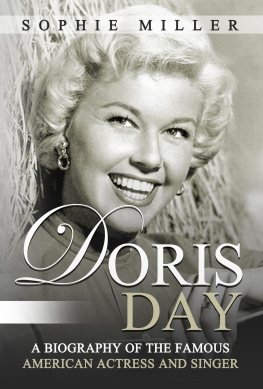Doris Day: A Biography of the Famous American Actress and Singer
By
Sophie Miller
Copyright 2020 - All rights reserved.
The content contained within this book may not be reproduced, duplicated or transmitted without direct written permission from the author or the publisher.
Under no circumstances will any blame or legal responsibility be held against the publisher, or author, for any damages, reparation, or monetary loss due to the information contained within this book, either directly or indirectly.
Legal Notice:
This book is copyright protected. It is only for personal use. You cannot amend, distribute, sell, use, quote or paraphrase any part, or the content within this book, without the consent of the author or publisher.
Disclaimer Notice:
Please note the information contained within this document is for educational and entertainment purposes only. All effort has been executed to present accurate, up to date, reliable, complete information. No warranties of any kind are declared or implied. Readers acknowledge that the author is not engaging in the rendering of legal, financial, medical or professional advice. The content within this book has been derived from various sources. Please consult a licensed professional before attempting any techniques outlined in this book.
By reading this document, the reader agrees that under no circumstances is the author responsible for any losses, direct or indirect, that are incurred as a result of the use of information contained within this document, including, but not limited to, errors, omissions, or inaccuracies.
TABLE OF CONTENTS
Im not going to go around with a long face thats a waste of time. Doris Day
D oris Day was beloved to the world as the quintessential 1950s woman. She was the blonde-haired, blue-eyed, "All-American Girl" that women aspired to be, and husbands wished their wives were. She was a woman revered by her fans, her critics, and aspiring starlets and stage actresses alike. Even after her death, the media celebrates Day's life and legacy as the gorgeous animal rights and welfare activist with the ultimate Hollywood start and classic "girl next door" persona.
The New York Times critic Charles Champlin summarized America's fascination with Day in a review published in 1988: "She conveyed a unique blend of innocent sexiness .... That was not so much the woman next door as the woman you wished lived next door."
Day had a reputation onscreen and in the media as being simultaneously sexual and virginal. Her characters and persona both maintained careers while appearing as domestic women, with the approachability of the clerk behind the counter, yet presenting an elegance reminiscent of more proper times. While Day outwardly enjoyed being the ideal 1950s woman, it became clear even to her that she was merely the epitome of a nonexistent, uncomplicated, uncomplaining image of modern womanhood.
Her persona was built to bely a career full of hard work, hardship, and hard marriages. At times, her superstardom only served as the antithesis of her private life, which was wrought throughout the years by physical injury, personal indignation, and financial ruin. She represented, to the public, husbands, aspiring housewives everywhere, a vanishing vision of what it meant to be the perfect woman. Yet, her own life served as the perfect example of an image of a woman far removed from reality. Day was, until the day of her death, the sexual virgin of Hollywood, the ultimate paradox of mid-century filmography and husbands' fantasies alike.
While the world often recognizes and celebrates Doris Day for her accomplishments onscreen and in the studio, Day would prefer to be remembered for her animal welfare work. Once she left the Hollywood life in the mid-1970s, she never looked back. She embraced her new life's mission: to protect animals and the people who wanted to protect them in turn. Day actively lobbied Congress for legislation on animal welfare and population control issues, worked to adopt out animals taken in by organizations she was associated with, and even pioneered Spay Day USA in 1995.
Day had a passionate love of animals from a young age and believed she had a soulful connection with each and every one. Famously, when she visited a horse that she sponsored through the SPCA, every other horse in the facility was drawn to her immediately. The staff at the center said they'd never seen their abused horses so affectionate with anyone, human or otherwise.
It was Day who summed up her life and her attitude about her work quite succinctly: "I think everything in my life led me to my animal welfare work."
Early Life (and Disaster)
The one radio voice that I listened to above others belonged to Ella Fitzgerald. There was a quality to her voice that fascinated me, and Id sing along with her, trying to catch the subtle ways she shaded her voice, the casual yet clean way she sang those words. Doris Day
T he woman the world knew and loved as Doris Day was born Doris Mary Anne von Kappelhoff on April 3, 1922, in Cincinnati, Ohio (though she believed until her 95th birthday she was born in 1924). Her mother, Alma Sophia, named her daughter after Almas favorite silent movie actress, Doris Kenyon.
Day's father was William Joseph von Kappelhoff. She had two brothers. The eldest, Richard, died before her birth. Paul was two years older. Both of her parents were first-generation German-Americans with parents who had immigrated from before their births.
Franz Joseph Wilhelm Kappelhoff was Day's paternal grandfather and a German immigrant who came to the United States in 1875. He settled his family in Cincinnati, Ohio, for the city's large German community, at that time chock full of German churches, clubs, and newspapers.
William Kappelhoff, Franz's son, was a choirmaster and music teacher, as well as the church organist for St. Mark's Catholic Church. He loved classical music, opera, and pretty women. Due to his infidelity with his wife's best friend (among other women), he and Alma divorced in 1934, when Day was twelve. Joseph married and moved in with his wife's best friend shortly thereafter.
Next page













